Psychology Report: Investigating Gender Influence on Hugging Behavior
VerifiedAdded on 2021/04/21
|14
|3137
|105
Report
AI Summary
This psychology report investigates the impact of gender on hugging behavior, using a 'Free Hugs' campaign featuring a Cookie Monster. The study involved 263 participants, collecting data through observation on whether males and females would hug the character. The research aimed to determine if females were more inclined to hug than males. The methodology included a chi-square test, odds ratio, and cross-tabulation analysis to test the hypotheses. Results indicated that females were more likely to hug the Cookie Monster, supporting the hypothesis that gender influences hugging preferences. The report also discusses limitations, ethical considerations, and recommendations for future research, highlighting the importance of physical affection and its psychological benefits. The statistical analysis showed a significant association between gender and the willingness to hug, concluding that gender is a factor influencing hugging behavior.

Running head: PSYCHOLOGY
Psychology
Name of the Student:
Name of the University:
Author’s note:
Psychology
Name of the Student:
Name of the University:
Author’s note:
Paraphrase This Document
Need a fresh take? Get an instant paraphrase of this document with our AI Paraphraser
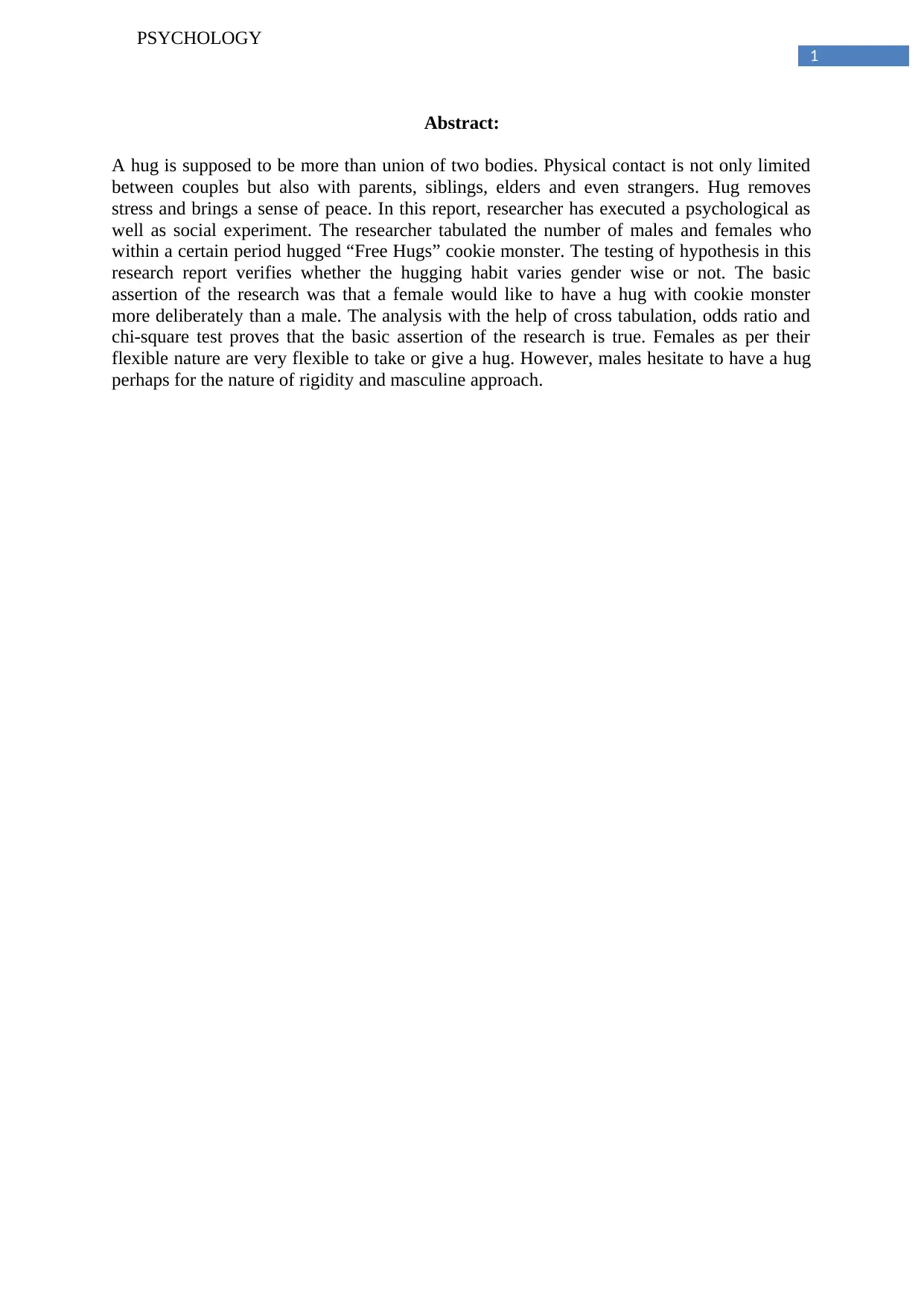
1
PSYCHOLOGY
Abstract:
A hug is supposed to be more than union of two bodies. Physical contact is not only limited
between couples but also with parents, siblings, elders and even strangers. Hug removes
stress and brings a sense of peace. In this report, researcher has executed a psychological as
well as social experiment. The researcher tabulated the number of males and females who
within a certain period hugged “Free Hugs” cookie monster. The testing of hypothesis in this
research report verifies whether the hugging habit varies gender wise or not. The basic
assertion of the research was that a female would like to have a hug with cookie monster
more deliberately than a male. The analysis with the help of cross tabulation, odds ratio and
chi-square test proves that the basic assertion of the research is true. Females as per their
flexible nature are very flexible to take or give a hug. However, males hesitate to have a hug
perhaps for the nature of rigidity and masculine approach.
PSYCHOLOGY
Abstract:
A hug is supposed to be more than union of two bodies. Physical contact is not only limited
between couples but also with parents, siblings, elders and even strangers. Hug removes
stress and brings a sense of peace. In this report, researcher has executed a psychological as
well as social experiment. The researcher tabulated the number of males and females who
within a certain period hugged “Free Hugs” cookie monster. The testing of hypothesis in this
research report verifies whether the hugging habit varies gender wise or not. The basic
assertion of the research was that a female would like to have a hug with cookie monster
more deliberately than a male. The analysis with the help of cross tabulation, odds ratio and
chi-square test proves that the basic assertion of the research is true. Females as per their
flexible nature are very flexible to take or give a hug. However, males hesitate to have a hug
perhaps for the nature of rigidity and masculine approach.

2
PSYCHOLOGY
Table of Contents
Introduction:..........................................................................................................................................3
Research Rationale:...............................................................................................................................3
Research Aim:.......................................................................................................................................3
Research Hypotheses:............................................................................................................................3
Literature review:..................................................................................................................................4
Methodology:........................................................................................................................................5
Design:..............................................................................................................................................5
Participants:.......................................................................................................................................5
Procedure:.........................................................................................................................................5
Materials/Measures:..........................................................................................................................6
Data Operating Tool:.........................................................................................................................6
Data Description:...................................................................................................................................6
Data Analysis:.......................................................................................................................................6
Cross-tab percentage table:...............................................................................................................6
Odds ratio calculation:......................................................................................................................6
Chi-Square calculation:.....................................................................................................................7
Hypotheses:...................................................................................................................................8
Test applied:..................................................................................................................................8
Level of significance:....................................................................................................................8
Calculated test statistic:.................................................................................................................8
Calculated p-value:........................................................................................................................8
Inference:.......................................................................................................................................8
Interpretation:................................................................................................................................8
Conclusion:..........................................................................................................................................10
Recommendation:................................................................................................................................10
Ethical Consideration:.........................................................................................................................10
Limitations:.........................................................................................................................................10
References:..........................................................................................................................................12
PSYCHOLOGY
Table of Contents
Introduction:..........................................................................................................................................3
Research Rationale:...............................................................................................................................3
Research Aim:.......................................................................................................................................3
Research Hypotheses:............................................................................................................................3
Literature review:..................................................................................................................................4
Methodology:........................................................................................................................................5
Design:..............................................................................................................................................5
Participants:.......................................................................................................................................5
Procedure:.........................................................................................................................................5
Materials/Measures:..........................................................................................................................6
Data Operating Tool:.........................................................................................................................6
Data Description:...................................................................................................................................6
Data Analysis:.......................................................................................................................................6
Cross-tab percentage table:...............................................................................................................6
Odds ratio calculation:......................................................................................................................6
Chi-Square calculation:.....................................................................................................................7
Hypotheses:...................................................................................................................................8
Test applied:..................................................................................................................................8
Level of significance:....................................................................................................................8
Calculated test statistic:.................................................................................................................8
Calculated p-value:........................................................................................................................8
Inference:.......................................................................................................................................8
Interpretation:................................................................................................................................8
Conclusion:..........................................................................................................................................10
Recommendation:................................................................................................................................10
Ethical Consideration:.........................................................................................................................10
Limitations:.........................................................................................................................................10
References:..........................................................................................................................................12
⊘ This is a preview!⊘
Do you want full access?
Subscribe today to unlock all pages.

Trusted by 1+ million students worldwide
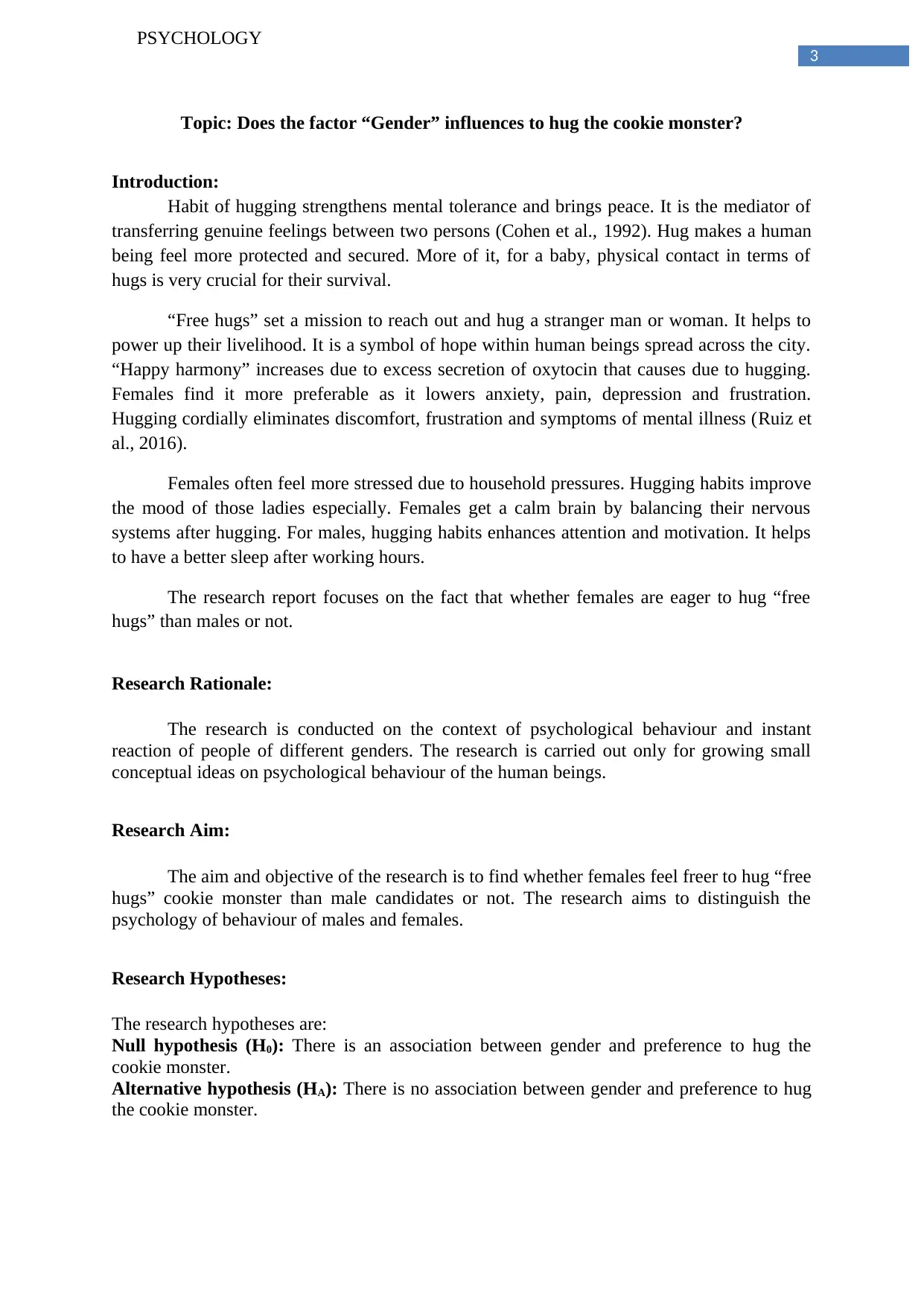
3
PSYCHOLOGY
Topic: Does the factor “Gender” influences to hug the cookie monster?
Introduction:
Habit of hugging strengthens mental tolerance and brings peace. It is the mediator of
transferring genuine feelings between two persons (Cohen et al., 1992). Hug makes a human
being feel more protected and secured. More of it, for a baby, physical contact in terms of
hugs is very crucial for their survival.
“Free hugs” set a mission to reach out and hug a stranger man or woman. It helps to
power up their livelihood. It is a symbol of hope within human beings spread across the city.
“Happy harmony” increases due to excess secretion of oxytocin that causes due to hugging.
Females find it more preferable as it lowers anxiety, pain, depression and frustration.
Hugging cordially eliminates discomfort, frustration and symptoms of mental illness (Ruiz et
al., 2016).
Females often feel more stressed due to household pressures. Hugging habits improve
the mood of those ladies especially. Females get a calm brain by balancing their nervous
systems after hugging. For males, hugging habits enhances attention and motivation. It helps
to have a better sleep after working hours.
The research report focuses on the fact that whether females are eager to hug “free
hugs” than males or not.
Research Rationale:
The research is conducted on the context of psychological behaviour and instant
reaction of people of different genders. The research is carried out only for growing small
conceptual ideas on psychological behaviour of the human beings.
Research Aim:
The aim and objective of the research is to find whether females feel freer to hug “free
hugs” cookie monster than male candidates or not. The research aims to distinguish the
psychology of behaviour of males and females.
Research Hypotheses:
The research hypotheses are:
Null hypothesis (H0): There is an association between gender and preference to hug the
cookie monster.
Alternative hypothesis (HA): There is no association between gender and preference to hug
the cookie monster.
PSYCHOLOGY
Topic: Does the factor “Gender” influences to hug the cookie monster?
Introduction:
Habit of hugging strengthens mental tolerance and brings peace. It is the mediator of
transferring genuine feelings between two persons (Cohen et al., 1992). Hug makes a human
being feel more protected and secured. More of it, for a baby, physical contact in terms of
hugs is very crucial for their survival.
“Free hugs” set a mission to reach out and hug a stranger man or woman. It helps to
power up their livelihood. It is a symbol of hope within human beings spread across the city.
“Happy harmony” increases due to excess secretion of oxytocin that causes due to hugging.
Females find it more preferable as it lowers anxiety, pain, depression and frustration.
Hugging cordially eliminates discomfort, frustration and symptoms of mental illness (Ruiz et
al., 2016).
Females often feel more stressed due to household pressures. Hugging habits improve
the mood of those ladies especially. Females get a calm brain by balancing their nervous
systems after hugging. For males, hugging habits enhances attention and motivation. It helps
to have a better sleep after working hours.
The research report focuses on the fact that whether females are eager to hug “free
hugs” than males or not.
Research Rationale:
The research is conducted on the context of psychological behaviour and instant
reaction of people of different genders. The research is carried out only for growing small
conceptual ideas on psychological behaviour of the human beings.
Research Aim:
The aim and objective of the research is to find whether females feel freer to hug “free
hugs” cookie monster than male candidates or not. The research aims to distinguish the
psychology of behaviour of males and females.
Research Hypotheses:
The research hypotheses are:
Null hypothesis (H0): There is an association between gender and preference to hug the
cookie monster.
Alternative hypothesis (HA): There is no association between gender and preference to hug
the cookie monster.
Paraphrase This Document
Need a fresh take? Get an instant paraphrase of this document with our AI Paraphraser

4
PSYCHOLOGY
Literature review:
A recipe for good life is proposed by positive psychology. It has shortened the narrow gap
between science and life (Sundararajan, 2005). A simple expression of positive psychology is
“Hugging”.
This age is a time when social dysconnectivity is prominent. People are facing lack of human
contact. In these circumstances, “Free Hugs” definitely has become a phenomenal aspect.
With the help of “Free Hugs campaign”, the original spirits of humanity come together
(Cohen, 2004). Such types of campaign are the landmarks of inspiration. Cookie Monster has
accepted the energetic attempt of socialistic approach of “Free Hugs” and made their brand-
new clothing.
(Source: Suzuki et al., 2016)
PSYCHOLOGY
Literature review:
A recipe for good life is proposed by positive psychology. It has shortened the narrow gap
between science and life (Sundararajan, 2005). A simple expression of positive psychology is
“Hugging”.
This age is a time when social dysconnectivity is prominent. People are facing lack of human
contact. In these circumstances, “Free Hugs” definitely has become a phenomenal aspect.
With the help of “Free Hugs campaign”, the original spirits of humanity come together
(Cohen, 2004). Such types of campaign are the landmarks of inspiration. Cookie Monster has
accepted the energetic attempt of socialistic approach of “Free Hugs” and made their brand-
new clothing.
(Source: Suzuki et al., 2016)
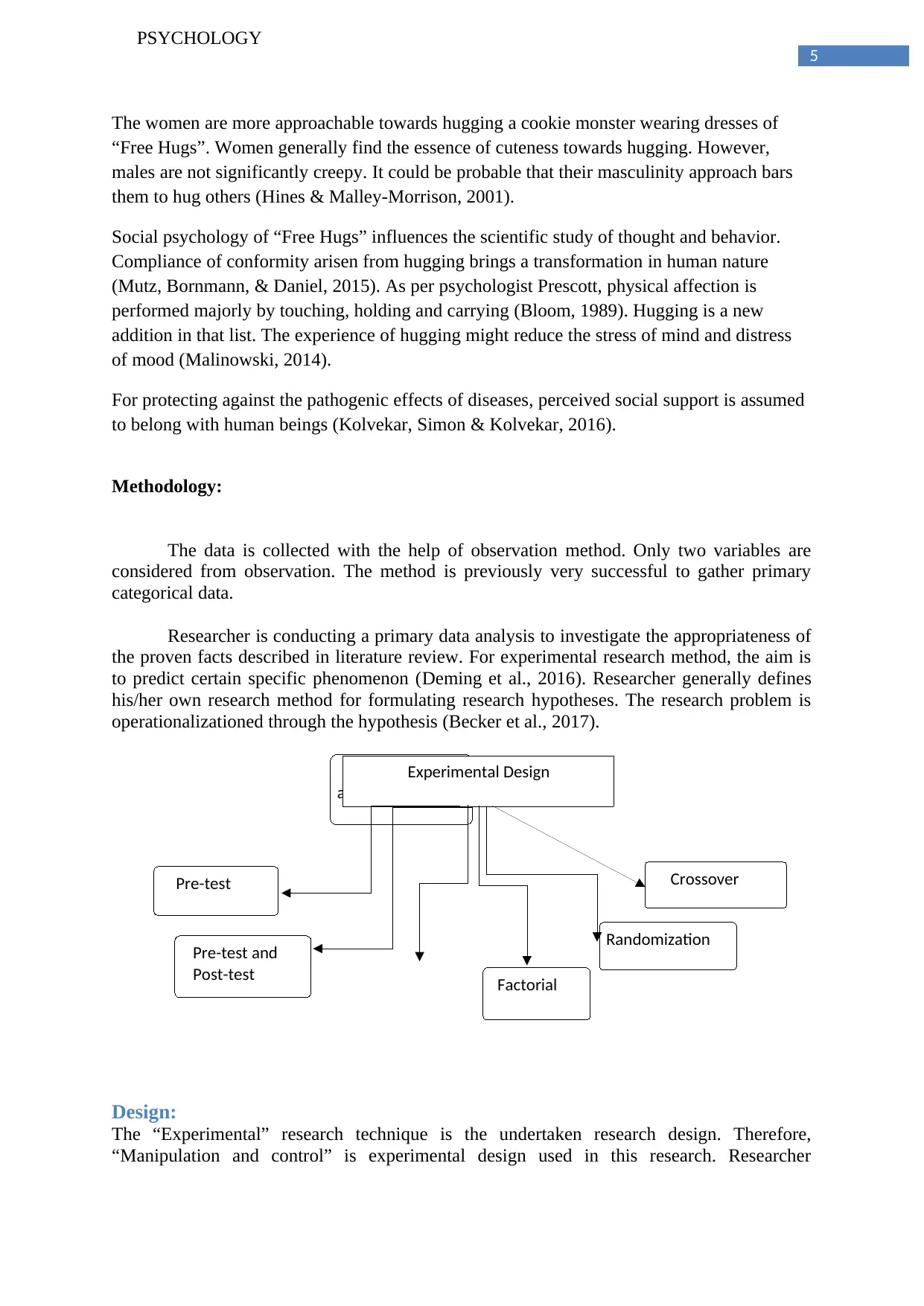
5
PSYCHOLOGY
The women are more approachable towards hugging a cookie monster wearing dresses of
“Free Hugs”. Women generally find the essence of cuteness towards hugging. However,
males are not significantly creepy. It could be probable that their masculinity approach bars
them to hug others (Hines & Malley-Morrison, 2001).
Social psychology of “Free Hugs” influences the scientific study of thought and behavior.
Compliance of conformity arisen from hugging brings a transformation in human nature
(Mutz, Bornmann, & Daniel, 2015). As per psychologist Prescott, physical affection is
performed majorly by touching, holding and carrying (Bloom, 1989). Hugging is a new
addition in that list. The experience of hugging might reduce the stress of mind and distress
of mood (Malinowski, 2014).
For protecting against the pathogenic effects of diseases, perceived social support is assumed
to belong with human beings (Kolvekar, Simon & Kolvekar, 2016).
Methodology:
The data is collected with the help of observation method. Only two variables are
considered from observation. The method is previously very successful to gather primary
categorical data.
Researcher is conducting a primary data analysis to investigate the appropriateness of
the proven facts described in literature review. For experimental research method, the aim is
to predict certain specific phenomenon (Deming et al., 2016). Researcher generally defines
his/her own research method for formulating research hypotheses. The research problem is
operationalizationed through the hypothesis (Becker et al., 2017).
Design:
The “Experimental” research technique is the undertaken research design. Therefore,
“Manipulation and control” is experimental design used in this research. Researcher
Manipulation
and Control
Factorial
Randomization
Crossover
Experimental Design
Pre-test
Pre-test and
Post-test
PSYCHOLOGY
The women are more approachable towards hugging a cookie monster wearing dresses of
“Free Hugs”. Women generally find the essence of cuteness towards hugging. However,
males are not significantly creepy. It could be probable that their masculinity approach bars
them to hug others (Hines & Malley-Morrison, 2001).
Social psychology of “Free Hugs” influences the scientific study of thought and behavior.
Compliance of conformity arisen from hugging brings a transformation in human nature
(Mutz, Bornmann, & Daniel, 2015). As per psychologist Prescott, physical affection is
performed majorly by touching, holding and carrying (Bloom, 1989). Hugging is a new
addition in that list. The experience of hugging might reduce the stress of mind and distress
of mood (Malinowski, 2014).
For protecting against the pathogenic effects of diseases, perceived social support is assumed
to belong with human beings (Kolvekar, Simon & Kolvekar, 2016).
Methodology:
The data is collected with the help of observation method. Only two variables are
considered from observation. The method is previously very successful to gather primary
categorical data.
Researcher is conducting a primary data analysis to investigate the appropriateness of
the proven facts described in literature review. For experimental research method, the aim is
to predict certain specific phenomenon (Deming et al., 2016). Researcher generally defines
his/her own research method for formulating research hypotheses. The research problem is
operationalizationed through the hypothesis (Becker et al., 2017).
Design:
The “Experimental” research technique is the undertaken research design. Therefore,
“Manipulation and control” is experimental design used in this research. Researcher
Manipulation
and Control
Factorial
Randomization
Crossover
Experimental Design
Pre-test
Pre-test and
Post-test
⊘ This is a preview!⊘
Do you want full access?
Subscribe today to unlock all pages.

Trusted by 1+ million students worldwide
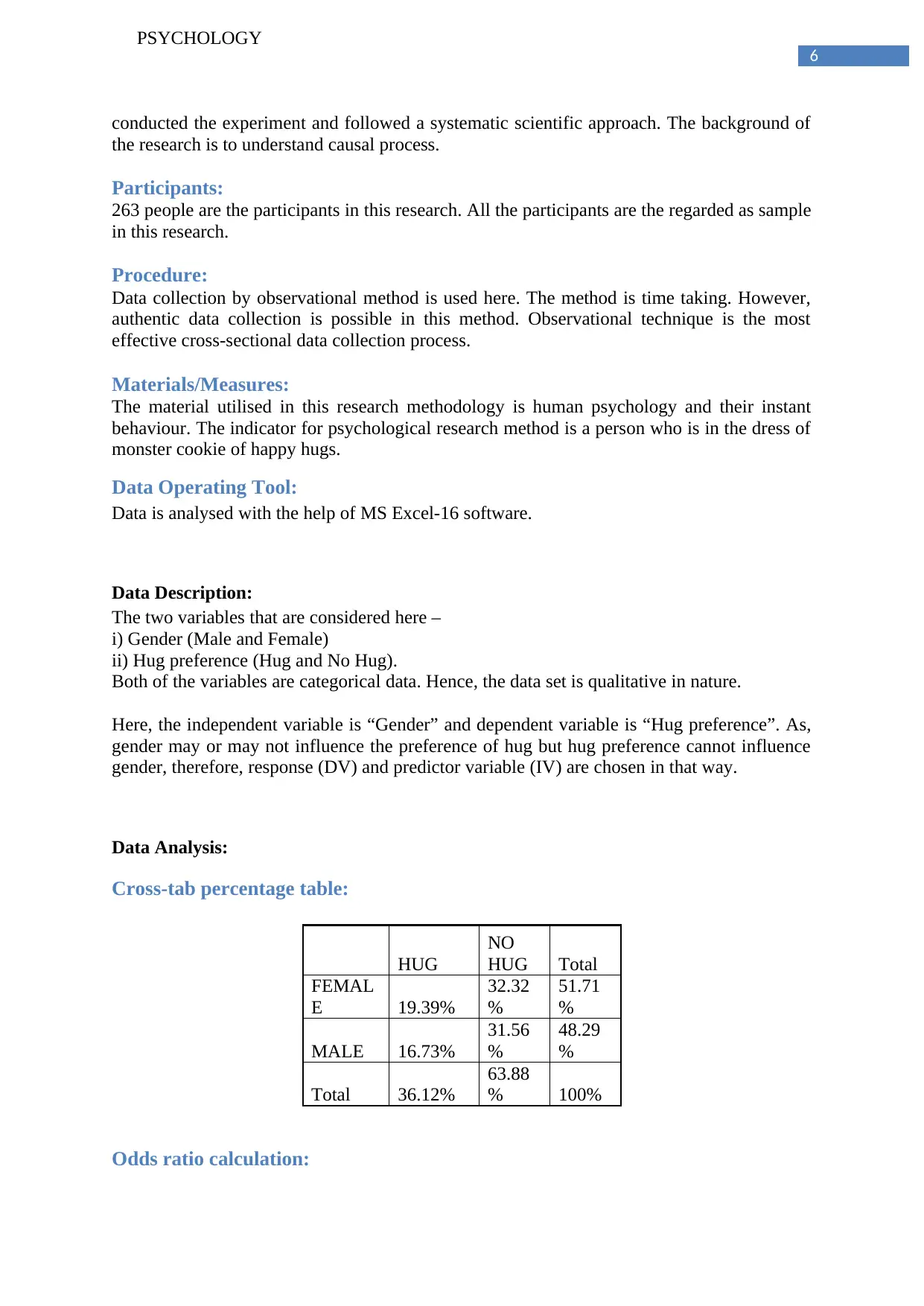
6
PSYCHOLOGY
conducted the experiment and followed a systematic scientific approach. The background of
the research is to understand causal process.
Participants:
263 people are the participants in this research. All the participants are the regarded as sample
in this research.
Procedure:
Data collection by observational method is used here. The method is time taking. However,
authentic data collection is possible in this method. Observational technique is the most
effective cross-sectional data collection process.
Materials/Measures:
The material utilised in this research methodology is human psychology and their instant
behaviour. The indicator for psychological research method is a person who is in the dress of
monster cookie of happy hugs.
Data Operating Tool:
Data is analysed with the help of MS Excel-16 software.
Data Description:
The two variables that are considered here –
i) Gender (Male and Female)
ii) Hug preference (Hug and No Hug).
Both of the variables are categorical data. Hence, the data set is qualitative in nature.
Here, the independent variable is “Gender” and dependent variable is “Hug preference”. As,
gender may or may not influence the preference of hug but hug preference cannot influence
gender, therefore, response (DV) and predictor variable (IV) are chosen in that way.
Data Analysis:
Cross-tab percentage table:
HUG
NO
HUG Total
FEMAL
E 19.39%
32.32
%
51.71
%
MALE 16.73%
31.56
%
48.29
%
Total 36.12%
63.88
% 100%
Odds ratio calculation:
PSYCHOLOGY
conducted the experiment and followed a systematic scientific approach. The background of
the research is to understand causal process.
Participants:
263 people are the participants in this research. All the participants are the regarded as sample
in this research.
Procedure:
Data collection by observational method is used here. The method is time taking. However,
authentic data collection is possible in this method. Observational technique is the most
effective cross-sectional data collection process.
Materials/Measures:
The material utilised in this research methodology is human psychology and their instant
behaviour. The indicator for psychological research method is a person who is in the dress of
monster cookie of happy hugs.
Data Operating Tool:
Data is analysed with the help of MS Excel-16 software.
Data Description:
The two variables that are considered here –
i) Gender (Male and Female)
ii) Hug preference (Hug and No Hug).
Both of the variables are categorical data. Hence, the data set is qualitative in nature.
Here, the independent variable is “Gender” and dependent variable is “Hug preference”. As,
gender may or may not influence the preference of hug but hug preference cannot influence
gender, therefore, response (DV) and predictor variable (IV) are chosen in that way.
Data Analysis:
Cross-tab percentage table:
HUG
NO
HUG Total
FEMAL
E 19.39%
32.32
%
51.71
%
MALE 16.73%
31.56
%
48.29
%
Total 36.12%
63.88
% 100%
Odds ratio calculation:
Paraphrase This Document
Need a fresh take? Get an instant paraphrase of this document with our AI Paraphraser

7
PSYCHOLOGY
The odds ratio would be calculated as:
( Females w h o preferred ¿ hug ¿¿ Males w h o preferred ¿ hug ¿)
( Females w h o did not prefer ¿ hug ¿¿ Males w h o did not prefer ¿ h ug¿) = ( Females w h o preferred ¿h ug )∗( Ma
( Males w h o preferred¿ hug )∗(Feal
= (51∗83)
( 44∗85) =1.131818.
As the odds ratio is higher than 1, therefore, there is a higher “odds” of “gender” happening
with exposure to the hugging preference (Grant, 2014).
That means a female hugs a cookie monster 1.13 times higher than a male hug.
Chi-Square calculation:
Table 1: The frequency table
HUG NO HUG
Total
actual
relative
frequency
FEMALE 51 85 136 0.52
MALE 44 83 127 0.48
Total 95 168 263
actual relative
frequency 0.36 0.64 1
The following facts are found from the previous frequency table:
Out of total 263 participants 136 (52%) are females and 127 (48%) are males.
Out of 263 participants 95 people (36%) preferred to hug cookie monster whereas 168
people (64%) did not hug cookie monster.
51 females choose to hug the cookie monster.
44 males preferred to hug the cookie monster.
85 females incurred to hug the cookie monster.
83 males incurred to hug the cookie monster.
Table 2: The Expected frequency table
HUG NO
HUG Tota
l
FEMAL
E 49.13 86.87 136
MALE 45.87 81.13 127
Total 95 168 263
Table 3: Table of Chi-square statistic calculation
HUG NO
HUG Total
PSYCHOLOGY
The odds ratio would be calculated as:
( Females w h o preferred ¿ hug ¿¿ Males w h o preferred ¿ hug ¿)
( Females w h o did not prefer ¿ hug ¿¿ Males w h o did not prefer ¿ h ug¿) = ( Females w h o preferred ¿h ug )∗( Ma
( Males w h o preferred¿ hug )∗(Feal
= (51∗83)
( 44∗85) =1.131818.
As the odds ratio is higher than 1, therefore, there is a higher “odds” of “gender” happening
with exposure to the hugging preference (Grant, 2014).
That means a female hugs a cookie monster 1.13 times higher than a male hug.
Chi-Square calculation:
Table 1: The frequency table
HUG NO HUG
Total
actual
relative
frequency
FEMALE 51 85 136 0.52
MALE 44 83 127 0.48
Total 95 168 263
actual relative
frequency 0.36 0.64 1
The following facts are found from the previous frequency table:
Out of total 263 participants 136 (52%) are females and 127 (48%) are males.
Out of 263 participants 95 people (36%) preferred to hug cookie monster whereas 168
people (64%) did not hug cookie monster.
51 females choose to hug the cookie monster.
44 males preferred to hug the cookie monster.
85 females incurred to hug the cookie monster.
83 males incurred to hug the cookie monster.
Table 2: The Expected frequency table
HUG NO
HUG Tota
l
FEMAL
E 49.13 86.87 136
MALE 45.87 81.13 127
Total 95 168 263
Table 3: Table of Chi-square statistic calculation
HUG NO
HUG Total
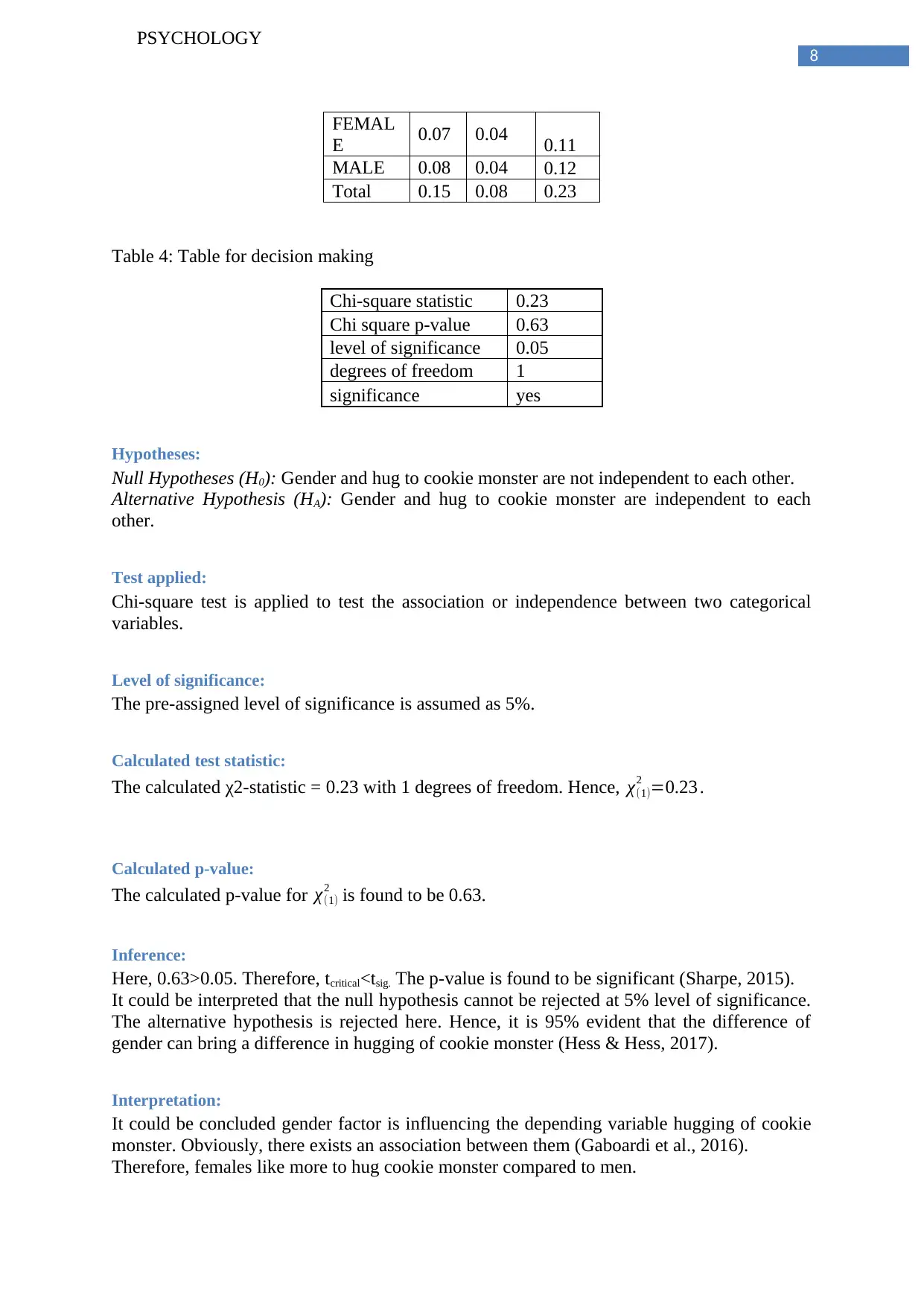
8
PSYCHOLOGY
FEMAL
E 0.07 0.04 0.11
MALE 0.08 0.04 0.12
Total 0.15 0.08 0.23
Table 4: Table for decision making
Chi-square statistic 0.23
Chi square p-value 0.63
level of significance 0.05
degrees of freedom 1
significance yes
Hypotheses:
Null Hypotheses (H0): Gender and hug to cookie monster are not independent to each other.
Alternative Hypothesis (HA): Gender and hug to cookie monster are independent to each
other.
Test applied:
Chi-square test is applied to test the association or independence between two categorical
variables.
Level of significance:
The pre-assigned level of significance is assumed as 5%.
Calculated test statistic:
The calculated χ2-statistic = 0.23 with 1 degrees of freedom. Hence, χ(1)
2 =0.23 .
Calculated p-value:
The calculated p-value for χ(1)
2 is found to be 0.63.
Inference:
Here, 0.63>0.05. Therefore, tcritical<tsig. The p-value is found to be significant (Sharpe, 2015).
It could be interpreted that the null hypothesis cannot be rejected at 5% level of significance.
The alternative hypothesis is rejected here. Hence, it is 95% evident that the difference of
gender can bring a difference in hugging of cookie monster (Hess & Hess, 2017).
Interpretation:
It could be concluded gender factor is influencing the depending variable hugging of cookie
monster. Obviously, there exists an association between them (Gaboardi et al., 2016).
Therefore, females like more to hug cookie monster compared to men.
PSYCHOLOGY
FEMAL
E 0.07 0.04 0.11
MALE 0.08 0.04 0.12
Total 0.15 0.08 0.23
Table 4: Table for decision making
Chi-square statistic 0.23
Chi square p-value 0.63
level of significance 0.05
degrees of freedom 1
significance yes
Hypotheses:
Null Hypotheses (H0): Gender and hug to cookie monster are not independent to each other.
Alternative Hypothesis (HA): Gender and hug to cookie monster are independent to each
other.
Test applied:
Chi-square test is applied to test the association or independence between two categorical
variables.
Level of significance:
The pre-assigned level of significance is assumed as 5%.
Calculated test statistic:
The calculated χ2-statistic = 0.23 with 1 degrees of freedom. Hence, χ(1)
2 =0.23 .
Calculated p-value:
The calculated p-value for χ(1)
2 is found to be 0.63.
Inference:
Here, 0.63>0.05. Therefore, tcritical<tsig. The p-value is found to be significant (Sharpe, 2015).
It could be interpreted that the null hypothesis cannot be rejected at 5% level of significance.
The alternative hypothesis is rejected here. Hence, it is 95% evident that the difference of
gender can bring a difference in hugging of cookie monster (Hess & Hess, 2017).
Interpretation:
It could be concluded gender factor is influencing the depending variable hugging of cookie
monster. Obviously, there exists an association between them (Gaboardi et al., 2016).
Therefore, females like more to hug cookie monster compared to men.
⊘ This is a preview!⊘
Do you want full access?
Subscribe today to unlock all pages.

Trusted by 1+ million students worldwide
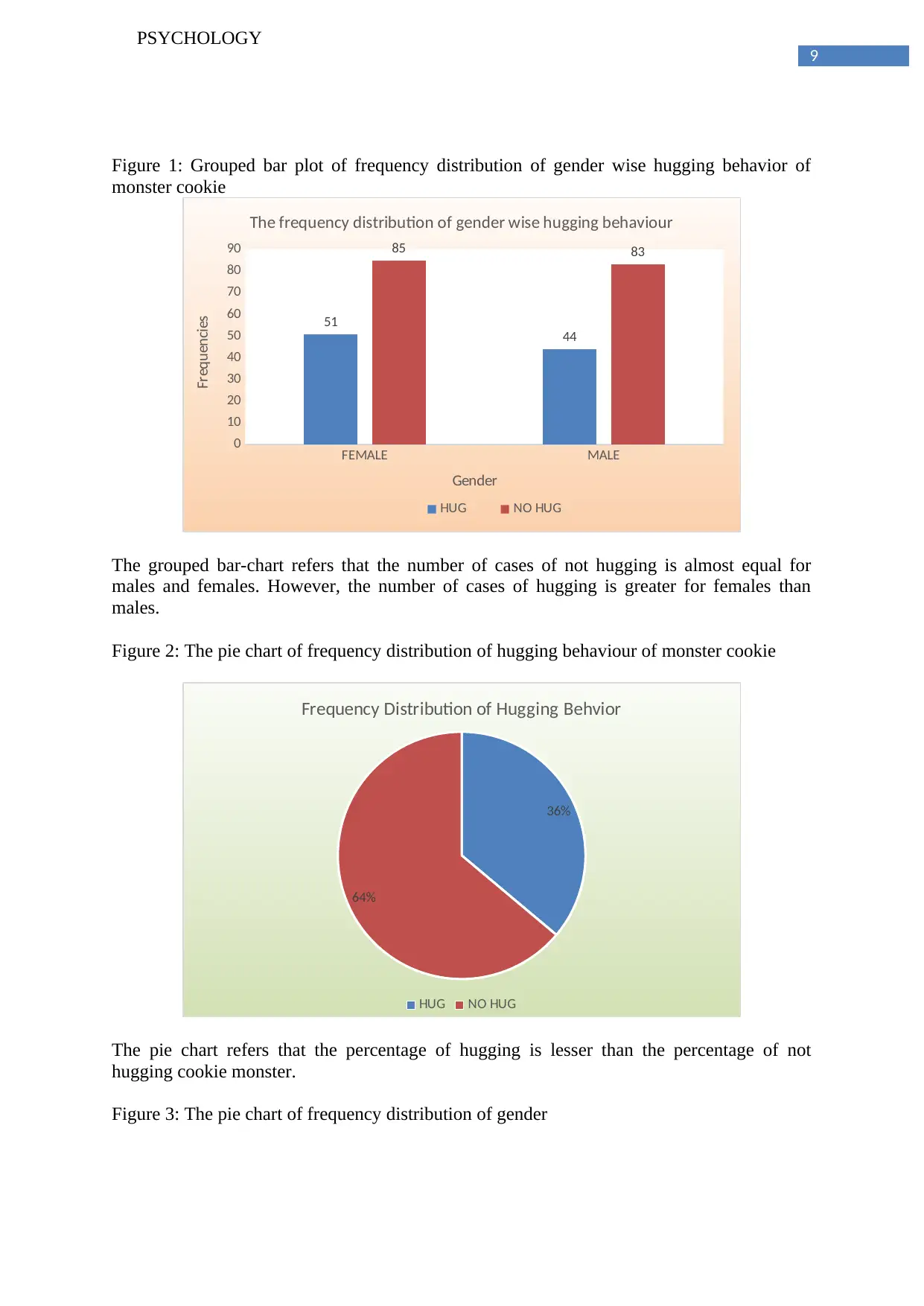
9
PSYCHOLOGY
Figure 1: Grouped bar plot of frequency distribution of gender wise hugging behavior of
monster cookie
FEMALE MALE
0
10
20
30
40
50
60
70
80
90
51
44
85 83
The frequency distribution of gender wise hugging behaviour
HUG NO HUG
Gender
Frequencies
The grouped bar-chart refers that the number of cases of not hugging is almost equal for
males and females. However, the number of cases of hugging is greater for females than
males.
Figure 2: The pie chart of frequency distribution of hugging behaviour of monster cookie
36%
64%
Frequency Distribution of Hugging Behvior
HUG NO HUG
The pie chart refers that the percentage of hugging is lesser than the percentage of not
hugging cookie monster.
Figure 3: The pie chart of frequency distribution of gender
PSYCHOLOGY
Figure 1: Grouped bar plot of frequency distribution of gender wise hugging behavior of
monster cookie
FEMALE MALE
0
10
20
30
40
50
60
70
80
90
51
44
85 83
The frequency distribution of gender wise hugging behaviour
HUG NO HUG
Gender
Frequencies
The grouped bar-chart refers that the number of cases of not hugging is almost equal for
males and females. However, the number of cases of hugging is greater for females than
males.
Figure 2: The pie chart of frequency distribution of hugging behaviour of monster cookie
36%
64%
Frequency Distribution of Hugging Behvior
HUG NO HUG
The pie chart refers that the percentage of hugging is lesser than the percentage of not
hugging cookie monster.
Figure 3: The pie chart of frequency distribution of gender
Paraphrase This Document
Need a fresh take? Get an instant paraphrase of this document with our AI Paraphraser
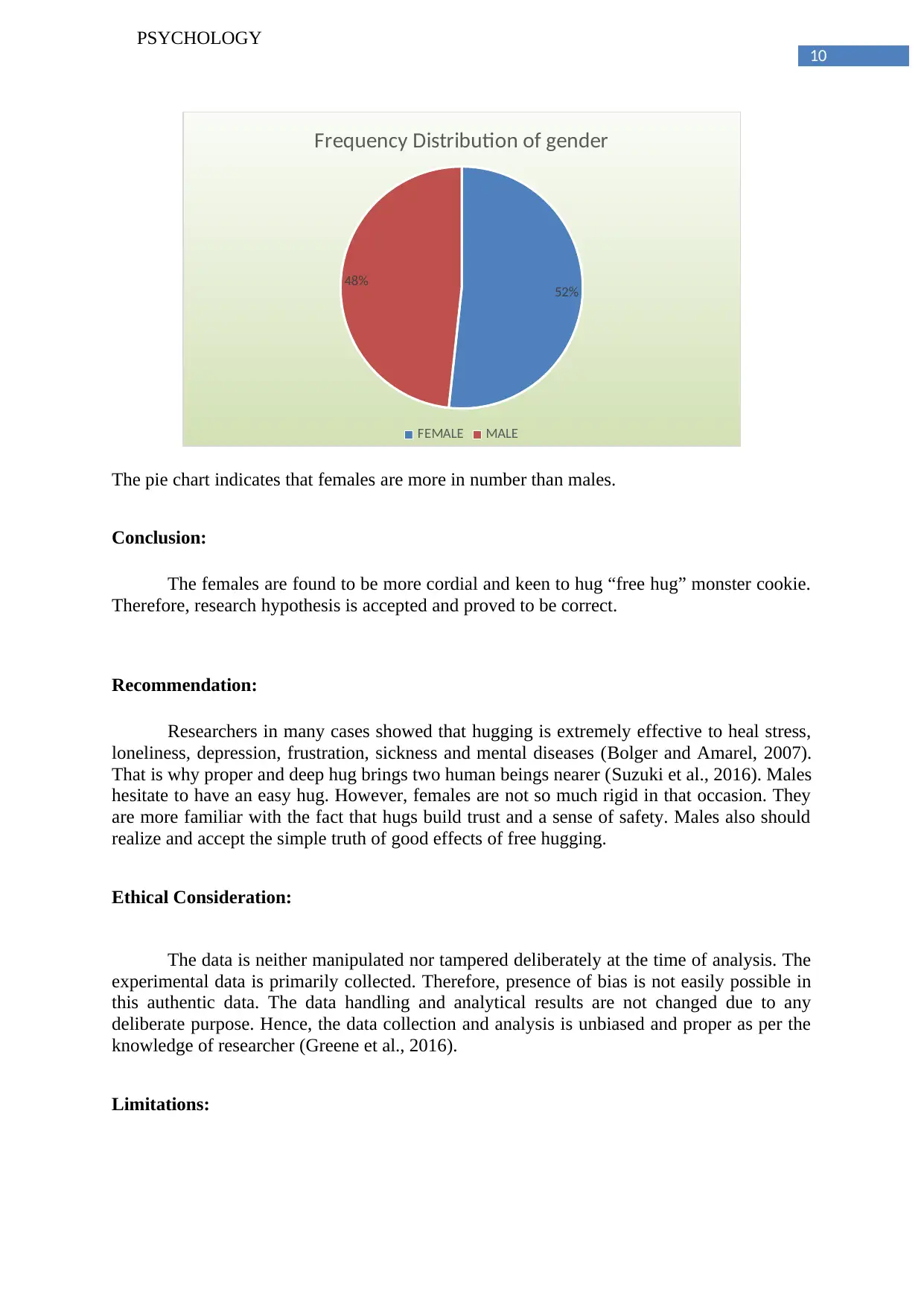
10
PSYCHOLOGY
52%
48%
Frequency Distribution of gender
FEMALE MALE
The pie chart indicates that females are more in number than males.
Conclusion:
The females are found to be more cordial and keen to hug “free hug” monster cookie.
Therefore, research hypothesis is accepted and proved to be correct.
Recommendation:
Researchers in many cases showed that hugging is extremely effective to heal stress,
loneliness, depression, frustration, sickness and mental diseases (Bolger and Amarel, 2007).
That is why proper and deep hug brings two human beings nearer (Suzuki et al., 2016). Males
hesitate to have an easy hug. However, females are not so much rigid in that occasion. They
are more familiar with the fact that hugs build trust and a sense of safety. Males also should
realize and accept the simple truth of good effects of free hugging.
Ethical Consideration:
The data is neither manipulated nor tampered deliberately at the time of analysis. The
experimental data is primarily collected. Therefore, presence of bias is not easily possible in
this authentic data. The data handling and analytical results are not changed due to any
deliberate purpose. Hence, the data collection and analysis is unbiased and proper as per the
knowledge of researcher (Greene et al., 2016).
Limitations:
PSYCHOLOGY
52%
48%
Frequency Distribution of gender
FEMALE MALE
The pie chart indicates that females are more in number than males.
Conclusion:
The females are found to be more cordial and keen to hug “free hug” monster cookie.
Therefore, research hypothesis is accepted and proved to be correct.
Recommendation:
Researchers in many cases showed that hugging is extremely effective to heal stress,
loneliness, depression, frustration, sickness and mental diseases (Bolger and Amarel, 2007).
That is why proper and deep hug brings two human beings nearer (Suzuki et al., 2016). Males
hesitate to have an easy hug. However, females are not so much rigid in that occasion. They
are more familiar with the fact that hugs build trust and a sense of safety. Males also should
realize and accept the simple truth of good effects of free hugging.
Ethical Consideration:
The data is neither manipulated nor tampered deliberately at the time of analysis. The
experimental data is primarily collected. Therefore, presence of bias is not easily possible in
this authentic data. The data handling and analytical results are not changed due to any
deliberate purpose. Hence, the data collection and analysis is unbiased and proper as per the
knowledge of researcher (Greene et al., 2016).
Limitations:
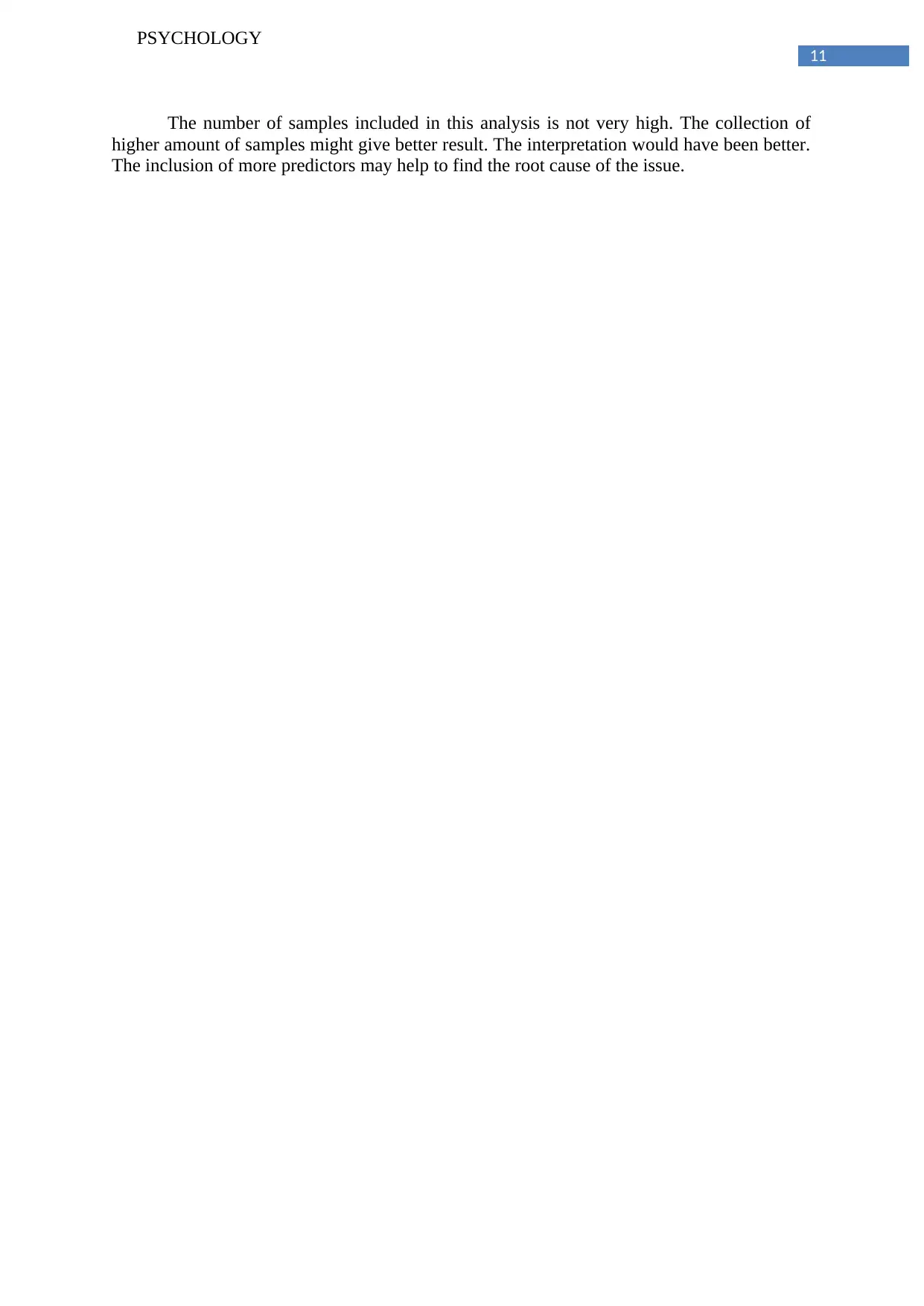
11
PSYCHOLOGY
The number of samples included in this analysis is not very high. The collection of
higher amount of samples might give better result. The interpretation would have been better.
The inclusion of more predictors may help to find the root cause of the issue.
PSYCHOLOGY
The number of samples included in this analysis is not very high. The collection of
higher amount of samples might give better result. The interpretation would have been better.
The inclusion of more predictors may help to find the root cause of the issue.
⊘ This is a preview!⊘
Do you want full access?
Subscribe today to unlock all pages.

Trusted by 1+ million students worldwide
1 out of 14
Related Documents
Your All-in-One AI-Powered Toolkit for Academic Success.
+13062052269
info@desklib.com
Available 24*7 on WhatsApp / Email
![[object Object]](/_next/static/media/star-bottom.7253800d.svg)
Unlock your academic potential
Copyright © 2020–2026 A2Z Services. All Rights Reserved. Developed and managed by ZUCOL.
